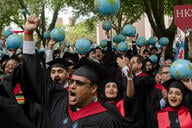You have /5 articles left.
Sign up for a free account or log in.
A new paper from the National Bureau of Economic Research examines the key findings of the Equality of Opportunity Project, which exploits a unique data set to assess the contributions that individual colleges make to intergenerational social mobility. The research received significant attention upon its public release last winter, including in Inside Higher Ed, but the paper released by NBER explores the findings in depth. The authors -- researchers at Stanford and Brown Universities; the University of California, Berkeley; and the U.S. Treasury Department -- assess colleges based on the number of students who come to the institution from families in the bottom quintile of family income and reach the top quintile.
While elite colleges do well under the metric, especially in driving students into the top 1 percent of Americans, the researchers find that many midtier public institutions -- many of those in the City University of New York and California State University systems, for instance -- have the highest rates of upward mobility.





